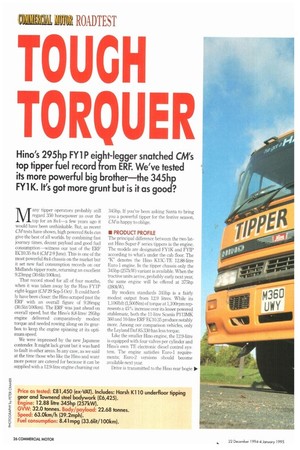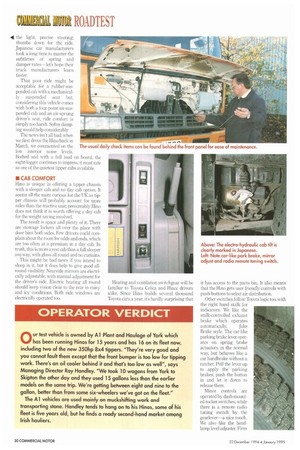TOUGH TORQU
Page 28

Page 30

Page 32

Page 33

If you've noticed an error in this article please click here to report it so we can fix it.
Hino's 295hp FY1P eight-legger snatched CM's top tipper fuel record from ERF. We've tested its more powerful big brother—the 345hp FY1K. It's got more grunt but is it as good?
Many tipper operators probably still regard 350 horsepower as over the top for an 8x4—a few years ago it would have been unthinkable. But, as recent CM tests have shown, high powered 8x4s can give the best of all worlds, by combining fast journey times, decent payload and good fuel consumption—witness our test of the ERF EC10.35 8x4 (CM 2-9 June). This is one of the most powerful 8x4 chassis on the market but it set new fuel consumption records on our Midlands tipper route, returning an excellent 9.23mpg (30.61it/100km).
That record stood for all of four months, when it was taken away by the Hino FY1P eight-legger (CM 29 Sep-5 Oct) . It could hardly have been closer: the Hino scraped past the ERF with an overall figure of 9.26mpg (30.51it/100km). The ERF was just ahead on overall speed, but the Hino's 8.8-litre/ 295hp engine delivered comparatively modest torque and needed rowing along on its gearbox to keep the engine spinning at its optimum speed.
We were impressed by the new Japanese contender. It might lack grunt but it was hard to fault in other areas. In any case, as we said at the time those who like the Hino and want more power are catered for because it can be supplied with a 12.9-litre engine churning out 345hp. If you've been asking Santa to bring you a powerful tipper for the festive season, CMis happy to oblige.
• PRODUCT PROFILE
The principal difference between the two latest Hino Super-F series tippers is the engine. The models are designated FY1K and FYIP according to what's under the cab floor. The "K" denotes the I lino K I 3C-TE 12.88-litre Euro-1 engine. In the tipper chassis only the 345hp (257kW) variant is available. When the tractive units arrive, probably early next year, the same engine will he offered at 375hp (280kW).
By modern standards 345hp is a fairly modest output from 12.9 litres. While its 1,1061bft (1,500Nm) of torque at 1,100rpm represents a 45% increase over its lesser powered stablemate, both the 11-litre Scania P113MK 360 and 10-litre ERF EC10.35 produce notably more. Among our comparison vehicles, only the Leyland Daf 85.330 has less torque.
Like the smaller Hino engine, the 12.9-litre is equipped with four valves per cylinder and Hino's own TE electronic diesel control system. The engine satisfies Euro-1 requirements; Euro-2 versions should become available next year.
Drive is transmitted to the Hino rear bogie PP.
4 via the Eaton RTX 11609B nine-speed constant-tnesh box which is also fitted to the 295hp models. Hino has made a slight revision to the clutch brake. On earlier models it was operated by a switch on the gear lever; on our test vehicle it has been shifted to the clutch pedal which has to be floored to activate it. As Hino points out, this is not an upshift brake; the clutch will suffer accelerated wear if it is used as such.
In all other respects, bar the rear axle ratios, the chassis is identical to the lower powered models.
• PRODUCTIVITY Our test vehicle came to us fresh from the hire fleet of Al Plant and Haulage in York. This particular model is one of the first 345hp 8x4s to reach the UK; it came to us with little more than 10,000km on the clock.
In the circumstances the overall fuel consumption of 8.41mpg (33.61it/100km) is very creditable. Although it lags behind the Scania and Leyland Daf in our comparison charts, it beats the Renault Maxter we tested recently Viewed as a large capacity engine for this type of truck, it's a good result by any standards. Given a few more miles under its belt we would expect the Hino to get much closer to the ERF's results. Looking at the section results, the motorway consumption of 9.56mpg (29.51it/100km) suggests that its gearing is better suited to motorway, rather than A-road work.
Like our listed comparison vehicles, the Hino was limited to 90km/h (56mph) on the motorway. That said, its overall average speed was down on many rivals, with both Aroad and motorway speeds slower than average. Given the effortless way this truck ate up the miles we were surprised that its overall speed wasn't higher.
Hinos have gained the reputation as solid and rugged workhorses, able to take the knocks rather than offering the last word in lightweight chassis. As we pointed out in our 295hp Hino test, the 12.9-litre engine adds around 185kg to the chassis weight.
Fully fuelled, our test vehicle offered a body/payload allowance of 22.68 tonnes, which is less than any of its listed rivals. However, this is unlikely to deter operators who want a sturdy chassis. Like the 295hp tipper our test vehicle was fitted with a steel body. This lifted its unladen weight to 12.46 tonnes; obviously payload would be boosted by an aluminium body, and alloy wheels would trim some more off the kerbweight.
• ON THE ROAD Four extra litres transforms the Hino eightlegger. While the 295hp model needed to have its engine spinning between 1,300-1,500rpm to get the best out of it, the 345hp engine is all torque, lugging down on demand to the bottom of its green sector at 800rpm. But in practice there's little to be gained by hanging on below the 1,100rpm torque summit.
This meant we could make less use of the Eaton constant-mesh eight-speeder than was necessary in the 295hp model. Not that using the box is much of a chore; like most constantmesh boxes it offers a fast, light change, once a driver has grasped the disciplines of constant mesh. The clutch can be dispensed with apart from starting or stopping.
In fact stopping is one of the Hino's strong points. The service brakes never failed to impress, providing powerful progressive stopping with relatively light pedal pressures.
Additional engine braking is provided by an exhaust brake, but we did not have much chance to try it out in the test. Firstly the speed limiter prevented us from blipping the throttle if the speed had risen to the limited speed on a motorway hill. This made it impossible to shift down a gear and lift engine revs to maximise the exhauster's effectiveness. Secondly, the exhaust brake microswitch is activated by the accelerator pedal linkage. On the second morning of the test we used the cold start control to increase tickover speed. When the engine had warmed up we wound the revs back again and, in the process, disconnected the exhaust brake microswitch.
It seems to us that the microswitch ought to be activated further along the accelerator linkage, or better still, by the engine's electronic control system. We feel there is a safety issue here. It should not be possible to switch off a safety device on a truck as simply as we (accidentally) managed on the Hino.
In the ride and handling stakes this Hino is, as expected, much the same as its lesser powered stablemate: full marks for handling and 110.
.4 the light, precise steering; thumbs down for the ride. Japanese car manufacturers took a long time to master the subtleties of spring and damper rates—let's hope their truck manufacturers learn faster.
That poor ride might be acceptable for a rubber-suspended cab with a mechanically suspended seat but, considering this vehicle comes with both a four-point air-suspended cab and an air-sprung driver's seat, ride comfort is simply too harsh. Softer damping would help considerably The news isn't all bad: when we first drove the Hino back in March, we commented on the low interior noise levels. Bodied and with a full load on board, the eight-legger continues to impress, it must rate as one of the quietest tipper albs available.
• CAB COMFORT Hino is unique in offering a tipper chassis with a sleeper cab and no day cab option. It seems all the more curious for the UK as tipper chassis will probably account for more sales than the tractive unit; presumably I lino does not think it is worth offering a day cab for the weight saving involved.
The result is space and plenty of it. There are stowage lockers all over the place with door bins both sides. Few drivers could complain about the room for odds and ends, which are too often at a premium in a day cab. In truth, this is more a rest cab than a full sleeper anyway, with glass all round and no curtains.
This might be bad news if you intend to sleep in it, but it does help to give good allround visibility Nearside mirrors are electrically adjustable, with manual adjustment for the driver's side. Electric heating all round should keep vision clear to the rear in rainy and icy conditions. Both side windows are electrically operated too. Heating and ventilation switchgear will be familiar to Toyota Celica and Hiacc drivers alike. Since IIino builds several thousand Toyota cars a year it's hardly surprising that it has access to the parts bin. It also means that the Hino gets user friendly controls with push-buttons to select air distribution.
Other switches follow Toyota logic too, with the right hand stalk for indicators. We like the stalk-controlled exhaust brake which operates automatically, Jake Brake style. The car-like parking brake lever operates on spring brake actuators in the normal way, but behaves like a car handbrake without a ratchet. Pull the lever up to apply the parking brakes; push the button in and let it down to release them.
Minor controls are operated by dash-mounted rocker switches, while there is a remote radio tuning switch by the gearlever—a nice touch. We also like the headlamp level adjuster. Firm ride aside, there's plenty of seat and steering column adjustment to accommodate all shapes and sizes behind the wheel. The steering wheel itself is adjustable for height and reach and you get all the usual adjustments for the seat, plus a lumbar adjustment and fold-down armrest.
Light-grey trim is used on all surfaces, with cloth facing on the seats. It may lighten the interior but after a few weeks' hire fleet work it was already showing the dirt.
• SUMMARY We can see this truck assuming the mantle of the old lveco Ford Maggie eight-wheeler: a bit heavy, but built to take the knocks. However, there is scope for Hino to reduce weight further anyway, most obviously by offering a day cab.
The only two drawbacks we can see are ride quality and price. The sophisticated cab suspension ought to deliver a much better ride than it does but a bit of fine tuning should resolve that particular shortcoming.
Barring heavy discounting, a competitive price might not be so easy to sort out. Hino is the victim of the rising Yen, making the FY1KUKA one of the most expensive 8x4 tippers on the market at .£75,025 (ex-VAT). Hino will have to shift production out of Japan to a lower priced economy if it wants to make a serious assault on the European truck market, and that's hardly likely at the moment with unfavourable market conditions.
Otherwise, the 345hp Hino is an impressive contender in the eight-legger market. In Japanese car manufacturing tradition the basic vehicle comes with a high level of equipment as standard. Add in good handling, reasonable economy, good build quality and a big lazy engine and you've got a package that will appeal to many tipper operators.
Li by John Kendall




















































































































